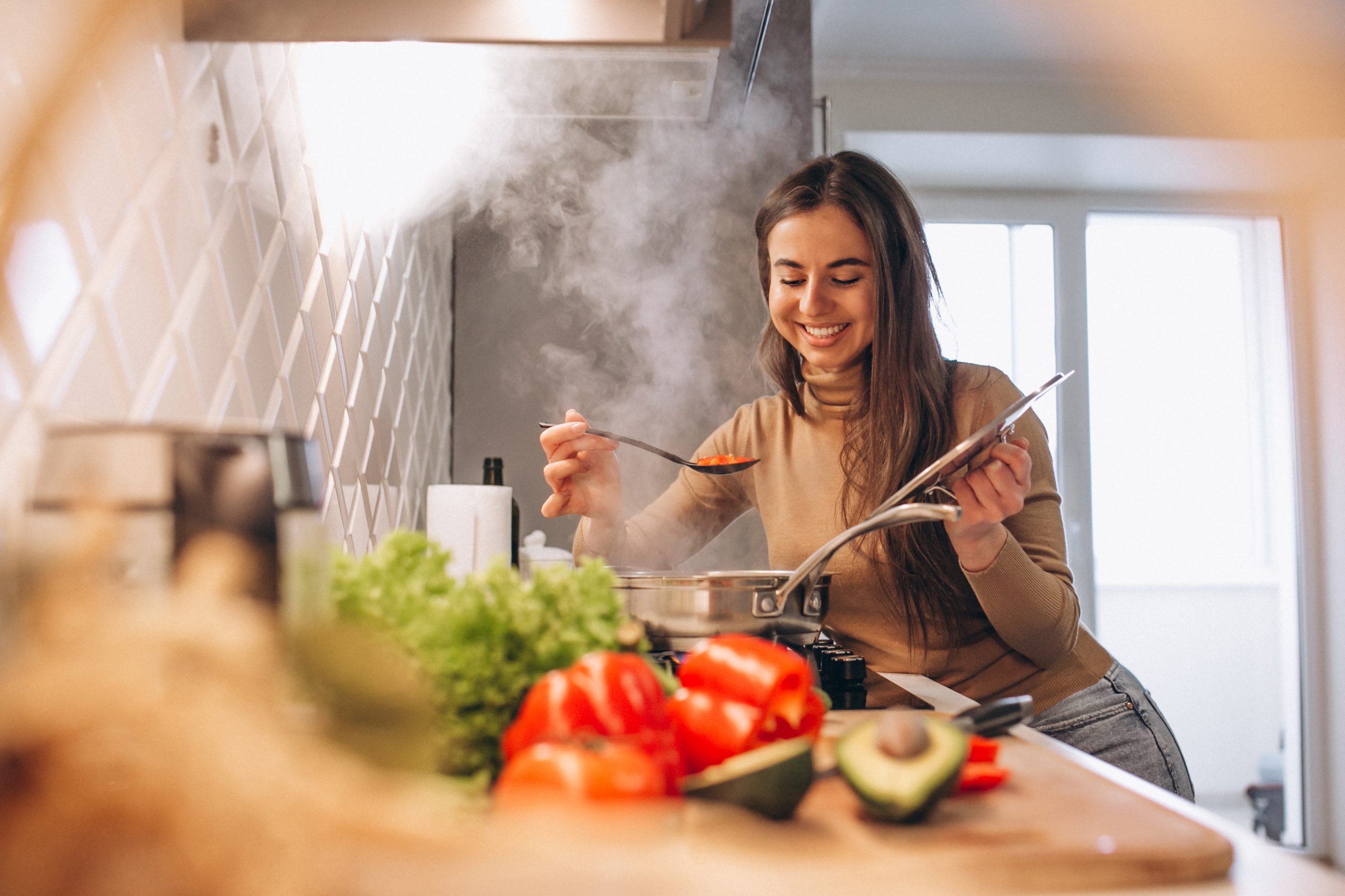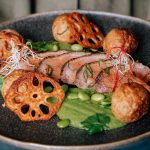This month Tomorrow has a special feature on veganism with an article on the pros and cons of a vegan diet from our wellbeing coach Ann de Jongh and vegan recipes from our new food contributor, Lita.

Being Vegan
WORDS Ann de Jongh
When I opened my vegetarian restaurant in the early 90s, being a vegetarian was not very common. Being vegan was a very small minority. Stereotypically it was “hippies” and animal activists – and often, they would look very thin and unhealthy! It was also based predominantly on eating brown bread/ rice/pasta and a very soya-based diet – so getting optimal protein was especially difficult.
Over the last ten years, being vegan has become a “normal” way to eat. When Veganuary started in 2014, 3000 people participated, and in 2022 over 629,000. There is a shift in people’s thinking about veganism. This has coincided with more research and talk about following a plantbased diet.
Putting plants, especially vegetables, fruit, nuts, legumes and seeds as the main part of your diet is the basis of the plant-based diet, which is often interchanged with being vegan – but they are not the same thing.
Being vegan means having no animal products or derivatives at all. Plant-based is about having plants as the centre of your diet, where the majority of your nutritional requirements come from, but with the addition of some animal products.
Both plant-based and vegan will require more creativity in the kitchen to ensure a fully balanced diet. Being vegan can mean it is harder to get your protein requirements. It often involves a lot of planning to ensure enough complete proteins are consumed. A lot of plants have protein, but none of them are a complete protein. You need to combine them to ensure you get the nine essential amino acids needed to make a complete protein. This is often why people are plant-based, as they feel they are lacking in protein. If you are plant-based, you can have some animal protein (which is a complete protein) when your body needs it to ensure optimal nutrition.
There are many pros and cons to being vegan, as well as being a carnivore, both from a health point of view and an environmental point of view – which is increasingly becoming a factor in what we put on our plate. However, we need to be careful if we are being vegan from an environmental viewpoint, thinking about where our food comes from, the seasonality as well as the distance it has travelled.
In the Algarve, we are all too aware of the problems that monoculture brings to the water supply from the massive avocado farms. Avocados are a big staple in a vegan diet, as they provide a lot of beneficial nutrients, but from an environmental point of view, they can have quite a heavy footprint from transportation and water. It is estimated to be around 200 litres of water to grow one avocado. By ensuring that we buy locally and in season, we can keep the environmental impact of our food choices much lower.
There is no denying the evidence that meat produces a bigger carbon footprint, so is therefore, less environmentally friendly. However, the choices we make in our plant-based foods can also have a negative impact on the environment.
From a health point of view, everyone’s health can benefit from eating more fruit and vegetables; the greater the variety, the better it is for us. This is often one reason why people feel so much better when they become vegan or plant-based, as they are being more creative in the kitchen, eating a wider variety of plants, and reducing the amount of red meat that they eat.
We need to find a way to eat that suits our body, our ethics and has the least impact on the environment. We want to ensure our bodies are fueled correctly to perform as we need them to, but we need to do this in a way that keeps our weight healthy that enables us to have a nutritionally dense and diverse diet that covers all food groups. It is full of a variety of plants, getting a good dose of antioxidants, eating foods that help our guts to be healthy, and to ensure we are getting enough protein for our needs, whether that is purely plant-based or there is some animal protein as well.
Whether you want to be vegan or to be predominantly plant-based, there is no doubt that increasing the number of vegetables and plants that you eat and reducing the amount of red meat has a positive effect on your health.
Ann de Jongh is a Health & Wellbeing Coach
+351 913 202 621
ann@fit2lovelife.com

Vegan Recipe – Chickpea curry with pumpkin and bulgur
WORDS Lita Santos
You can eat chickpeas (grão de bico) throughout the year. They are an excellent source of protein and provide many health benefits, which is great for vegans.
This recipe is perfectly suitable for the autumn and winter months because it is highly nutritious and warms you from the inside.

Ingredients for four people
- 1 cup bulgur
- 2 cups water (for the bulgur)
- ½ Pumpkin medium size
- 1 can of coconut milk
- Take 6x tbsp coconut milk for the sauce
- ¼ cup cashew
- 500g chickpeas
- 1 red onion
- 3 garlic
- 1 tbsp Sunflower oil (you can use a pot or wok)
- 1 medium size eggplant (you can peel if you prefer)
Spices
- ¼ tsp turmeric
- Salt
- Pepper
- ½ tsp cumin
- 1 tsp bio curry
- Chilli (If you like spicy)
How to prepare bulgur
It is very easy to prepare bulgur and takes only around 15 minutes. Put the bulgur in cold water and bring it to a boil. As soon as the water is boiling, lower the heat and let it swell for 10 minutes.
The Pumpkin
Peel and cut the pumpkin into slim slices and put it into a baking pan.
Cashew coconut milk sauce
Grind the cashew in a blender, then add coconut milk (6x tbsp), turmeric, salt and pepper or chilli, for the ones who like it spicy. Cover the pumpkin with the sauce and put it in the preheated oven for 20-25 minutes at 160ºc.
Chickpea Curry
Chop the red onion and the garlic, and cut the eggplant into cubes.
Put sunflower oil in a pot or wok, then add the onions first. After one minute add the eggplant and the garlic along with two tbsp of water and stir fry for around 5 minutes. Next add the cooked chickpeas, the coconut milk, cumin, curry, salt and pepper or chilli, let it cook for 10 more minutes and it is ready to serve.
Top Tip
The easy way is to buy the chickpeas precooked in a can or glass.
If you have time and want to prepare other recipes with the chickpeas, like burgers, falafel or hummus, it is better to buy dry chickpeas and soak them in water for one day.
Drain the water into a separate container, put the chickpeas in a pot, cover them with fresh water and cook them until you can crush the peas with a fork easily.
You can use the water, known as aquafaba for other recipes, such as vegan mayonnaise, a stock for soups, sauces and stew or for baking vegan cakes, which will be described in the upcoming issues.


Lalitana Vegan Kitchen
Lita Santos is Portuguese but lived for several years in Germany. She is a vegetarian/vegan chef specialising in Ayurveda nutrition, cooking with local seasonal ingredients. Her food is international, delicious and nourishing. She was the owner of the vegetarian restaurant Lalitana in Lagos. After closing the restaurant and taking a break for two years, she is back cooking vegan food for private events.
+351 914 061 143
We would love to see your culinary triumphs. If you cook any of the recipes in this edition please take a photo and send it to us and we will print it in the next magazine. Happy cooking!
sophie@tomorrowalgarve.com
Whatsapp: +351 912 176 588













